The announced program called the “Polish Deal” includes a proposal that entrepreneurs will pay a health insurance premium of 9% of their income, while the health insurance premium will not be tax deductible.
Such a significant change in the conditions of running a business will certainly affect the profitability of many enterprises in the country and is a good opportunity to rethink the form of business. According to the planned changes, the new higher health premium will be paid by entrepreneurs running sole entrepreneurships and partners in partnerships who are also treated as entrepreneurs.
In the event of the enactment and entry into force of new regulations, a change in the form of business activity may be considered in order to minimize the negative effects of this health contribution. One possibility is to run a business in the form of a limited liability company. In the case of this entity, if the company has more than one shareholder, and the share of the other shareholder is not symbolic (e.g. 1% to 5% of shares), the shareholders are not subject to the obligation to pay the health insurance premium. The management board of a limited liability company, if no employment contracts or contracts have been concluded with members of the management board, are also not subject to the obligatory health insurance contribution. The remuneration of the management board of a limited liability company, set out in the shareholders’ resolution, for performing functions in the management board is only subject to taxation under general rules.
The above means that in the event of the entry into force of the “Polish Deal”, the remuneration will be based on the tax-free amount of thirty thousand zlotys. In addition, this remuneration is settled according to the general tax scale, that is 17% and 32%, and the higher tax rate, in accordance with the proposed changes, will only apply to income above one hundred and twenty thousand zlotys. Summing up, the income from being member of the management board of a limited liability company, settled according to the tax scale up to the amount of PLN 120,000.00 per year, will be taxed at the rate of 17% and will be entitled to a tax-free amount, as well as to tax reliefs and joint settlement with the spouse. The remuneration of the management board is a tax-deductible cost for the limited liability company. The above option seems attractive compared to running a business unchanged, where the non-deductible 9% health insurance contribution will apply, the base flat tax rate is 19% and the lack of possibility to benefit from both reliefs and joint settlement with spouse. Additionally, it should be noted that the shareholders of the limited liability company and, partially, the management board are not liable with their private assets for the company’s obligations, so there is an additional benefit in the form of asset protection.
Considering converting a sole proprietorship into a limited liability company one should also take into account the fact that after the transformation itself, a one-person limited liability company will be created, with the transformed entrepreneur as the sole shareholder. In this form, the sole partner will be obliged to pay the health insurance premium. It will be necessary to carry out further actions, that is sell the shares to another entity, so that the company has at least two shareholders.
So how do you go from a sole proprietorship or partnership to a limited liability company?
Basically, there are two options: setting up a new limited liability company beside the entrepreneurship and then closing the business or partnership, or transforming the existing sole proprietorship partnership into a limited liability company.
Establishing a new company will be a reasonable solution only in the case if one’s conducting a small-scale business, having one contractor, limited business assets or a partnership. In such cases, the costs and time related to the transformation may be higher than registering a new entity, especially if we use the online registration of the company in the s24 system. In the event of establishing a new entity, it will be necessary to transfer the assets to the new entity and a possible assignment of contracts.
The second way to start a business in the form of a limited liability company is to transform existing activities. The undoubted advantage of using the transformation procedure is the fact that the limited liability company that will be created as a result of the transformation will be entitled to all the rights and obligations that the entrepreneur was previously entitled to. The company will automatically be a party to all contracts previously concluded by the entrepreneur, as well as all licenses and permits will be transferred to it. The law allows for transformation into a limited liability company of:
– sole proprietorship,
– civil law partnership,
– commercial partnerships (general partnership, limited partnership).
The conversion procedure differs quite significantly between a sole proprietorship and partnerships and civil law partnership, with a sole proprietorship being longer, more costly and more formalized.
Transformation of a sole proprietorship into a limited liability company requires the following actions:
– in the first place, the entrepreneur is obliged to prepare a transformation plan, which must be in the form of a notarial deed. The plan must obligatorily specify the carrying amount of the property of the transformed entrepreneur on a specific day in the month preceding the drawing up of the transformation plan. The Act indicates other necessary documents, which constitute attachments to the plan: draft of the entrepreneur’s declaration on the transformation, draft of the company’s memorandum of association, as well as the valuation of the company’s assets (assets and liabilities) and the report prepared for the purpose of the transformation on a specific day in the month preceding the date of preparation conversion plan;
– afterwards, the conversion plan with attachments is subject to an audit by a statutory auditor appointed by the registry court. The expert is obliged to examine the plan in terms of reliability and correctness within two months, and then submit an opinion to the registry court;
– after an opinion is submitted by a statutory auditor, the transforming entrepreneur submits, in the form of a notarial deed, a declaration of transformation into a capital company, the declaration should contain, in particular, the type of company into which the transformation takes place, the scope of personal rights granted to the entrepreneur as a shareholder in the newly established company, the amount of capital in the company, personal data of the management board;
– in the next stage, the entrepreneur signs the limited liability company contract and appoints the management board;
– the last step is to submit an application to the National Court Register and register the company, upon entry of the transformed company into the register, the entrepreneur is obliged to delete the activity from CeiDG (the registry for sole proprietorship and civil partnerships);
– The transformed company is also required to announce the transformation in public announcement. Upon transformation, the entrepreneur becomes the sole shareholder of the limited liability company, with the registration as limited liability company also the obligation to keep commercial books arises.
The process of transforming a civil law partnership or partnership contains the same elements, but is generally simpler and shorter. Pursuant to the amendment to the Commercial Companies Code of March 2020, the transformation of general partnerships and civil partnerships may take place in a simplified procedure, provided that all partners of the company handle its affairs. Simplified transformation requires the following steps:
– the first stage is the preparation of a resolution on transformation, which must be signed by all partners, the legislator resigned from the need to prepare a transformation plan and audit it by a statutory auditor;
– next, the only document determined by the legislator as necessary is the financial statement prepared for the purposes of the transformation;
– the last stage is signing the agreement of the transformed company and submitting the application to the registry court, conclusion of the limited liability company agreement requires the form of a notarial deed.
The simplified procedure allows to transformation of a general partnership or civil partnership in a much shorter time than the transformation of a sole proprietorship. The time needed for the transformation is shorter by approx. 2-3 months. Moreover, the cost of the procedure is significantly reduced as the audit by an auditor is one of the most significant costs when transforming a sole proprietorship. Transformation of an entrepreneur or partnership into a limited liability company unfortunately it does not come only with benefits. There are some drawbacks as running a business in the form of a limited liability company is subject to corporate income tax (CIT), the so-called full accounting, is mandatory. The above drawbacks might increase the day to day costs of running a business. It is also worth noting that the transformed entrepreneur is liable with personal assets for three years from the date of transformation. The decision to transform should be preceded by a comprehensive analysis of the potential benefits and risks related to the transformation.


